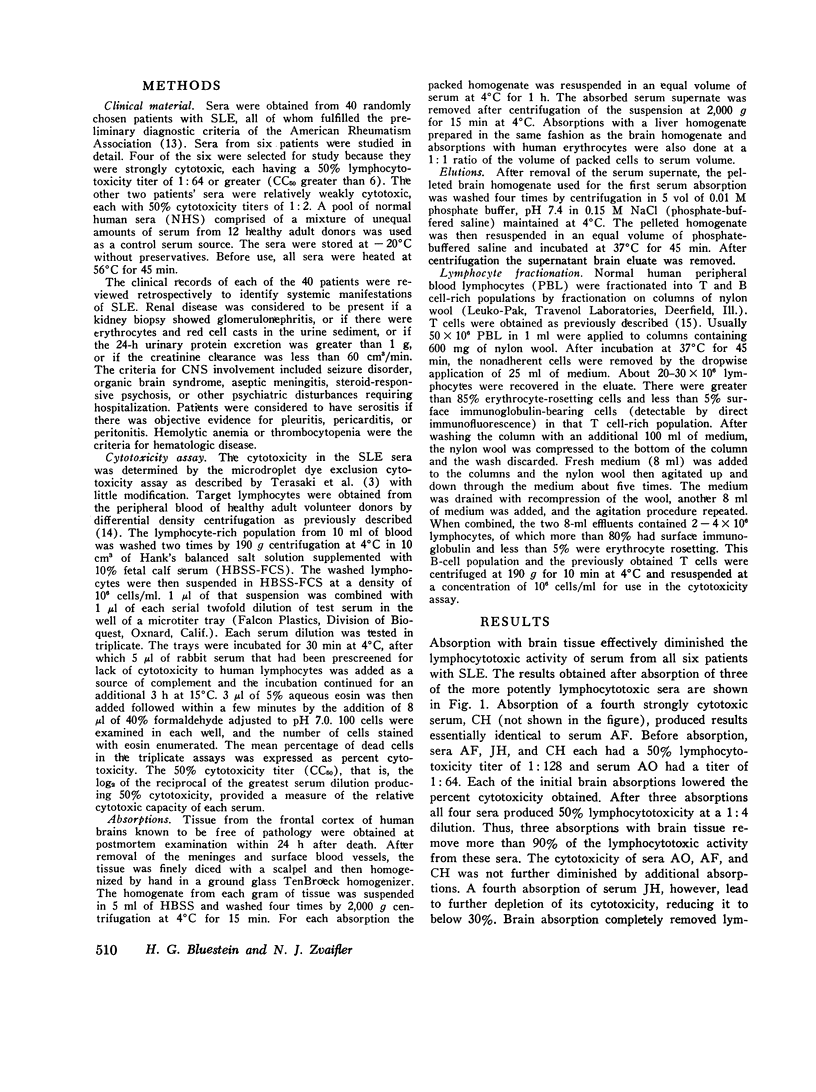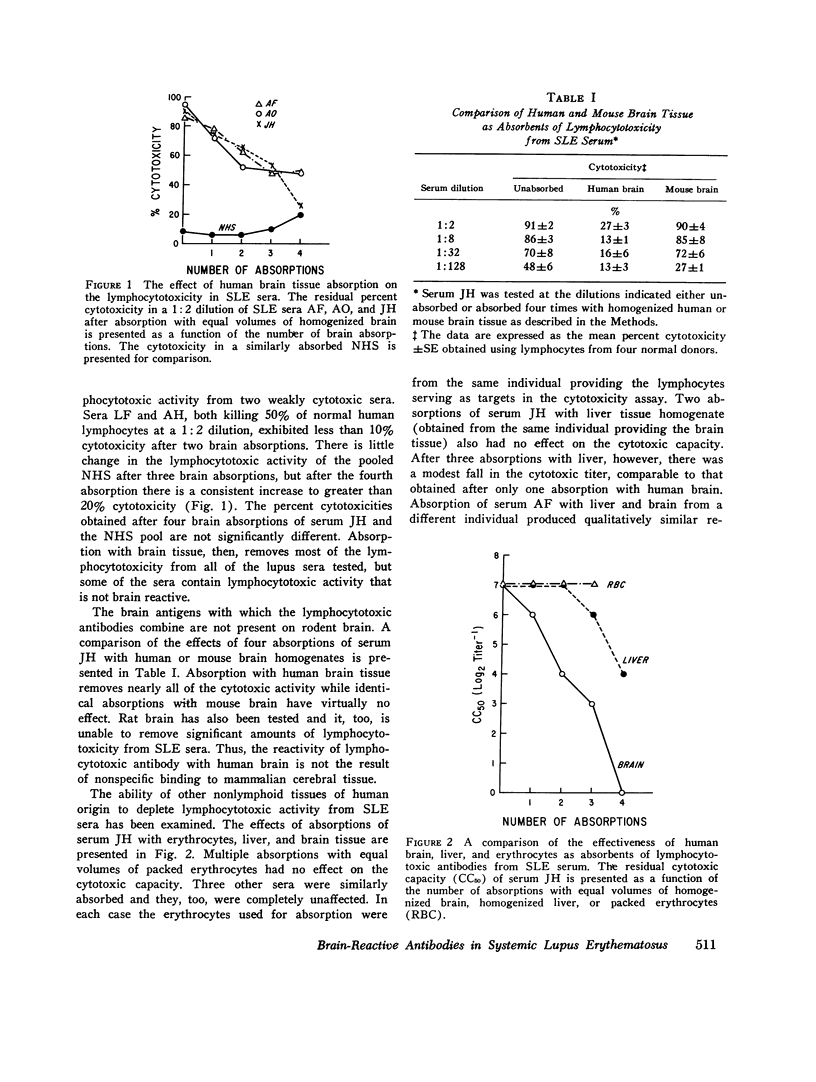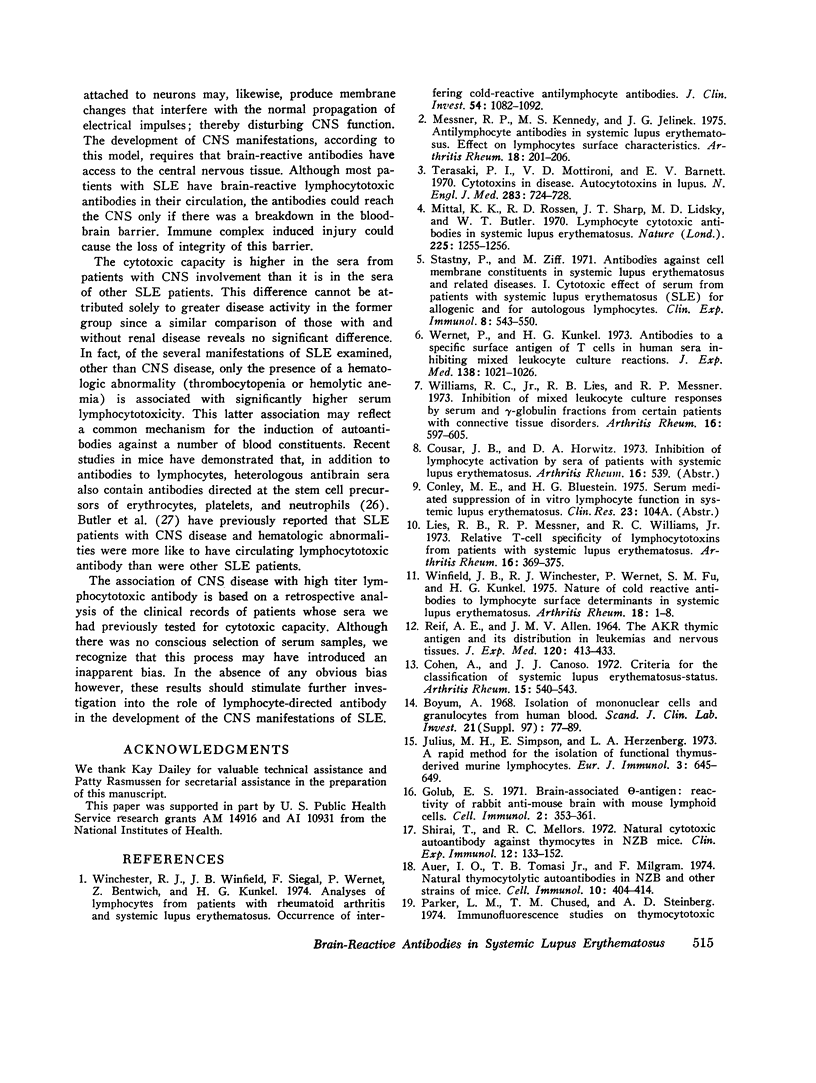Abstract
Homogenized tissue from the frontal cortex of normal human brains obtained at postmortem examination was used to absorb lymphocytotoxic antibody from the serum of six patients with systemic lupus erythematosus (SLE). Four absorptions of all of the SLE sera with equal volumes of homogenized brain tissue at 4 degrees C depleted their cytotoxic capacity more than 90%. Three of the six sera, however, retained some lymphocytotoxicity despite extensive brain absorption. Absorbed lymphocytotoxic antibodies were eluted from brain tissue absorbents at 37 degrees C. Cytotoxicity of the brain eluates was blocked by antibodies to human IgM (mu-chain specific) but not anti-IgG. The unabsorbed SLE sera, brain-absorbed sera, and brain eluates were equally cytotoxic to T (thymus-derived) and B (bone marrow-derived) cells fractionated from normal human peripheral blood lymphocytes. Thus, the lymphocytotoxic antibodies in SLE serum exhibit no preference for circulating human T cells. An analysis of the clinical records of 40 patients with SLE whose serum cytotoxic capacity had been determined revealed that circulating lymphocytotoxicity is greater in sera of patients with central nervous system (CNS) manifestations than in other SLE patients. This observation suggests a possible role for brain-reactive lymphocytotoxic antibodies in the development of CNS disease in SLE.
Full text
PDF







Selected References
These references are in PubMed. This may not be the complete list of references from this article.
- Atkins C. J., Kondon J. J., Quismorio F. P., Friou G. J. The choroid plexus in systemic lupus erythematosus. Ann Intern Med. 1972 Jan;76(1):65–72. doi: 10.7326/0003-4819-76-1-65. [DOI] [PubMed] [Google Scholar]
- Auer I. O., Tomasi T. B., Jr, Milgrom F. Natural thymocytolytic autoantibodies in NZB and other strains of mice. Cell Immunol. 1974 Mar 15;10(3):404–414. doi: 10.1016/0008-8749(74)90132-4. [DOI] [PubMed] [Google Scholar]
- Bluestein H. G. Alloantiserum-mediated suppression of histocompatibility-linked Ir-gene-controlled immune responses. Suppressive effects of IgG fragments derived from alloantisera. J Exp Med. 1974 Aug 1;140(2):481–493. doi: 10.1084/jem.140.2.481. [DOI] [PMC free article] [PubMed] [Google Scholar]
- Böyum A. Isolation of mononuclear cells and granulocytes from human blood. Isolation of monuclear cells by one centrifugation, and of granulocytes by combining centrifugation and sedimentation at 1 g. Scand J Clin Lab Invest Suppl. 1968;97:77–89. [PubMed] [Google Scholar]
- Cohen A. S., Canoso J. J. Criteria for the classification of systemic lupus erythematosus--status 1972. Arthritis Rheum. 1972 Sep-Oct;15(5):540–543. doi: 10.1002/art.1780150512. [DOI] [PubMed] [Google Scholar]
- Golub E. S. Brain-associated stem cell antigen: an antigen shared by brain and hemopoietic stem cells. J Exp Med. 1972 Aug 1;136(2):369–374. doi: 10.1084/jem.136.2.369. [DOI] [PMC free article] [PubMed] [Google Scholar]
- Golub E. S. Brain-associated theta antigen: reactivity of rabbit anti-mouse brain with mouse lymphoid cells. Cell Immunol. 1971 Aug;2(4):353–361. doi: 10.1016/0008-8749(71)90070-0. [DOI] [PubMed] [Google Scholar]
- Julius M. H., Simpson E., Herzenberg L. A. A rapid method for the isolation of functional thymus-derived murine lymphocytes. Eur J Immunol. 1973 Oct;3(10):645–649. doi: 10.1002/eji.1830031011. [DOI] [PubMed] [Google Scholar]
- Kay D. M., Tuffanelli D. L. Immunofluorescent techniques in clinical diagnosis of cutaneous disease. Ann Intern Med. 1969 Oct;71(4):753–762. doi: 10.7326/0003-4819-71-4-753. [DOI] [PubMed] [Google Scholar]
- Lies R. B., Messner R. P., Williams R. C., Jr Relative T-cell specificity of lymphocytotoxins from patients with systemic lupus erythematosus. Arthritis Rheum. 1973 May-Jun;16(3):369–375. doi: 10.1002/art.1780160312. [DOI] [PubMed] [Google Scholar]
- Luria E. A., Domashneva I. V. Antibodies to thymocytes in sera of patients with schizophrenia. Proc Natl Acad Sci U S A. 1974 Jan;71(1):235–236. doi: 10.1073/pnas.71.1.235. [DOI] [PMC free article] [PubMed] [Google Scholar]
- Messner R. P., Kennedy M. S., Jelinek J. G. Antilymphocyte antibodies in systemic lupus erythematosus. Effect on lymphocyte surface characteristics. Arthritis Rheum. 1975 May-Jun;18(3):201–206. doi: 10.1002/art.1780180302. [DOI] [PubMed] [Google Scholar]
- Mittal K. K., Rossen R. D., Sharp J. T., Lidsky M. D., Butler W. T. Lymphocyte cytotoxic antibodies in systemic lupus erythematosus. Nature. 1970 Mar 28;225(5239):1255–1256. doi: 10.1038/2251255a0. [DOI] [PubMed] [Google Scholar]
- Parker L. M., Chused T. M., Steinberg A. D. Immunofluorescence studies on thymocytotoxic antibody from New Zealand Black mice. J Immunol. 1974 Jan;112(1):285–292. [PubMed] [Google Scholar]
- REIF A. E., ALLEN J. M. THE AKR THYMIC ANTIGEN AND ITS DISTRIBUTION IN LEUKEMIAS AND NERVOUS TISSUES. J Exp Med. 1964 Sep 1;120:413–433. doi: 10.1084/jem.120.3.413. [DOI] [PMC free article] [PubMed] [Google Scholar]
- Shirai T., Mellors R. C. Natural cytotoxic autoantibody against thymocytes in NZB mice. Clin Exp Immunol. 1972 Sep;12(1):133–152. [PMC free article] [PubMed] [Google Scholar]
- Stastny P., Ziff M. Antibodies against cell membrane constituents in systemic lupus erythematosus and related diseases. I. Cytotoxic effect of serum from patients with systemic lupus erythematosus (SLE) for allogeneic and for autologous lymphocytes. Clin Exp Immunol. 1971 Apr;8(4):543–550. [PMC free article] [PubMed] [Google Scholar]
- Terasaki P. I., Mottironi V. D., Barnett E. V. Cytotoxins in disease. Autocytotoxins in lupus. N Engl J Med. 1970 Oct 1;283(14):724–728. doi: 10.1056/NEJM197010012831403. [DOI] [PubMed] [Google Scholar]
- Van den Noort S., Stjernholm R. L. Lymphotoxic activity in multiple sclerosis serum. Neurology. 1971 Aug;21(8):783–793. doi: 10.1212/wnl.21.8.783. [DOI] [PubMed] [Google Scholar]
- Wernet P., Kunkel H. G. Antibodies to a specific surface antigen of T cells in human sera inhibiting mixed leukocyte culture reactions. J Exp Med. 1973 Oct 1;138(4):1021–1026. doi: 10.1084/jem.138.4.1021. [DOI] [PMC free article] [PubMed] [Google Scholar]
- Williams R. C., Jr, Lies R. B., Messner R. P. Inhibition of mixed leukocyte culture responses by serum and gamma-globulin fractions from certain patients with connective tissue disorders. Arthritis Rheum. 1973 Sep-Oct;16(5):597–605. doi: 10.1002/art.1780160504. [DOI] [PubMed] [Google Scholar]
- Winchester R. J., Winfield J. B., Siegal F., Wernet P., Bentwich Z., Kunkel H. G. Analyses of lymphocytes from patients with rheumatoid arthritis and systemic lupus erythematosus. Occurrence of interfering cold-reactive antilymphocyte antibodies. J Clin Invest. 1974 Nov;54(5):1082–1092. doi: 10.1172/JCI107852. [DOI] [PMC free article] [PubMed] [Google Scholar]
- Winfield J. B., Winchester R. J., Wernet P., Fu S. M., Kunkel H. G. Nature of cold-reactive antibodies to lymphocyte surface determinants in systemic lupus erythematosus. Arthritis Rheum. 1975 Jan-Feb;18(1):1–8. doi: 10.1002/art.1780180101. [DOI] [PubMed] [Google Scholar]


